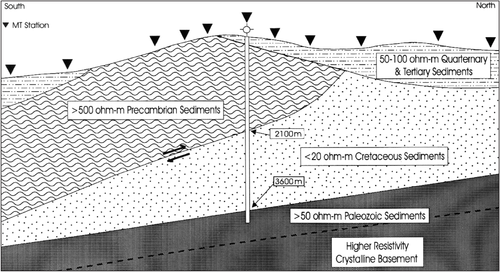Magnetotellurics case history: Precambrian overthrust (Northwestern Colorado)
Magnetotellurics (MT) can be used in an overthrust environment to delineate conductive sediments beneath a resistive thrust plate. It is often difficult to acquire good-quality seismic data in an overthrust area where high-velocity (high-resistivity, low-conductivity) rocks overlie low-velocity (low-resistivity, high-conductivity) sediments.
The Precambrian overthrust in the Bear Springs area of northwestern Colorado is an example.[1]
Survey results[edit]
The MT station near the drill hole (see diagram Figure 1) shows a thin, near-surface conductor on top of the resistive Precambrian thrust sheet. This is a wedge of Quaternary and Tertiary sediments. Beneath the thrust, a thick conductive section of Cretaceous sediments is observed.
Figure 1 is an 11-station MT profile across the thrust.
Structural details[edit]
These data provide the following structural details:
- Thickness of Quaternary and Tertiary cover
- Thickness of Precambrian thrust sheet
- Thinning of Cretaceous sediments to the south
- Depth to top of Paleozoic sediments
- No differentiation between Paleozoic and basement
A very detailed subsurface structural map could be obtained in this area using a 3-D grid, controlled-source MT survey depicting the Precambrian-Cretaceous thrust contact and the top of the Paleozoic section.
See also[edit]
- Magnetotellurics
- Magnetotellurics survey measurements
- Magnetotelluric data acquisition
- Magnetotellurics case history: frontier basin analysis (Amazon Basin, Colombia)
- Magnetotellurics case history: rugged carbonate terrain (Highlands of Papua New Guinea)
- Magnetotellurics case history: volcanic terrain (Columbia River Plateau)
